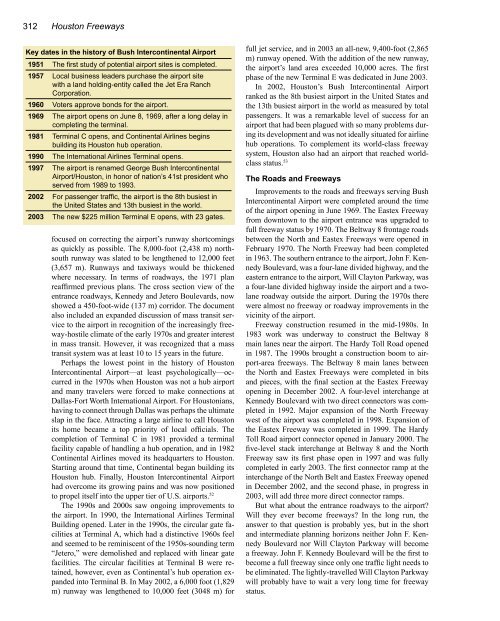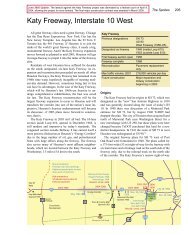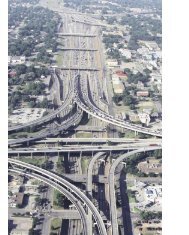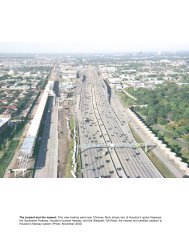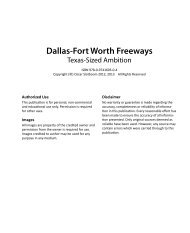You also want an ePaper? Increase the reach of your titles
YUMPU automatically turns print PDFs into web optimized ePapers that Google loves.
312 <strong>Houston</strong> Freeways<br />
Key dates in the history of Bush Intercontinental Airport<br />
1951 The first study of potential airport sites is completed.<br />
1957 Local business leaders purchase the airport site<br />
with a land holding-entity called the Jet Era Ranch<br />
Corporation.<br />
1960 Voters approve bonds for the airport.<br />
1969 The airport opens on June 8, 1969, after a long delay in<br />
completing the terminal.<br />
1981 Terminal C opens, and Continental Airlines begins<br />
building its <strong>Houston</strong> hub operation.<br />
1990 The International Airlines Terminal opens.<br />
1997 The airport is renamed George Bush Intercontinental<br />
Airport/<strong>Houston</strong>, in honor of nation’s 41st president who<br />
served from 1989 to 1993.<br />
2002 For passenger traffic, the airport is the 8th busiest in<br />
the United States and 13th busiest in the world.<br />
2003 The new $225 million Terminal E opens, with 23 gates.<br />
focused on correcting the airport’s runway shortcomings<br />
as quickly as possible. The 8,000-foot (2,438 m) northsouth<br />
runway was slated to be lengthened to 12,000 feet<br />
(3,657 m). Runways and taxiways would be thickened<br />
where necessary. In terms of roadways, the 1971 plan<br />
reaffirmed previous plans. The cross section view of the<br />
entrance roadways, Kennedy and Jetero Boulevards, now<br />
showed a 450-foot-wide (137 m) corridor. The document<br />
also included an expanded discussion of mass transit service<br />
to the airport in recognition of the increasingly freeway-hostile<br />
climate of the early 1970s and greater interest<br />
in mass transit. However, it was recognized that a mass<br />
transit system was at least 10 to 15 years in the future.<br />
Perhaps the lowest point in the history of <strong>Houston</strong><br />
Intercontinental Airport—at least psychologically—occurred<br />
in the 1970s when <strong>Houston</strong> was not a hub airport<br />
and many travelers were forced to make connections at<br />
Dallas-Fort Worth International Airport. For <strong>Houston</strong>ians,<br />
having to connect through Dallas was perhaps the ultimate<br />
slap in the face. Attracting a large airline to call <strong>Houston</strong><br />
its home became a top priority of local officials. The<br />
completion of Terminal C in 1981 provided a terminal<br />
facility capable of handling a hub operation, and in 1982<br />
Continental Airlines moved its headquarters to <strong>Houston</strong>.<br />
Starting around that time, Continental began building its<br />
<strong>Houston</strong> hub. Finally, <strong>Houston</strong> Intercontinental Airport<br />
had overcome its growing pains and was now positioned<br />
to propel itself into the upper tier of U.S. airports. 52<br />
The 1990s and 2000s saw ongoing improvements to<br />
the airport. In 1990, the International Airlines Terminal<br />
Building opened. Later in the 1990s, the circular gate facilities<br />
at Terminal A, which had a distinctive 1960s feel<br />
and seemed to be reminiscent of the 1950s-sounding term<br />
“Jetero,” were demolished and replaced with linear gate<br />
facilities. The circular facilities at Terminal B were retained,<br />
however, even as Continental’s hub operation expanded<br />
into Terminal B. In May 2002, a 6,000 foot (1,829<br />
m) runway was lengthened to 10,000 feet (3048 m) for<br />
full jet service, and in 2003 an all-new, 9,400-foot (2,865<br />
m) runway opened. With the addition of the new runway,<br />
the airport’s land area exceeded 10,000 acres. The first<br />
phase of the new Terminal E was dedicated in June 2003.<br />
In 2002, <strong>Houston</strong>’s Bush Intercontinental Airport<br />
ranked as the 8th busiest airport in the United States and<br />
the 13th busiest airport in the world as measured by total<br />
passengers. It was a remarkable level of success for an<br />
airport that had been plagued with so many problems during<br />
its development and was not ideally situated for airline<br />
hub operations. To complement its world-class freeway<br />
system, <strong>Houston</strong> also had an airport that reached worldclass<br />
status. 53<br />
The Roads and Freeways<br />
Improvements to the roads and freeways serving Bush<br />
Intercontinental Airport were completed around the time<br />
of the airport opening in June 1969. The Eastex Freeway<br />
from downtown to the airport entrance was upgraded to<br />
full freeway status by 1970. The <strong>Beltway</strong> 8 frontage roads<br />
between the North and Eastex Freeways were opened in<br />
February 1970. The North Freeway had been completed<br />
in 1963. The southern entrance to the airport, John F. Kennedy<br />
Boulevard, was a four-lane divided highway, and the<br />
eastern entrance to the airport, Will Clayton <strong>Parkway</strong>, was<br />
a four-lane divided highway inside the airport and a twolane<br />
roadway outside the airport. During the 1970s there<br />
were almost no freeway or roadway improvements in the<br />
vicinity of the airport.<br />
Freeway construction resumed in the mid-1980s. In<br />
1983 work was underway to construct the <strong>Beltway</strong> 8<br />
main lanes near the airport. The Hardy Toll Road opened<br />
in 1987. The 1990s brought a construction boom to airport-area<br />
freeways. The <strong>Beltway</strong> 8 main lanes between<br />
the North and Eastex Freeways were completed in bits<br />
and pieces, with the final section at the Eastex Freeway<br />
opening in December 2002. A four-level interchange at<br />
Kennedy Boulevard with two direct connectors was completed<br />
in 1992. Major expansion of the North Freeway<br />
west of the airport was completed in 1998. Expansion of<br />
the Eastex Freeway was completed in 1999. The Hardy<br />
Toll Road airport connector opened in January 2000. The<br />
five-level stack interchange at <strong>Beltway</strong> 8 and the North<br />
Freeway saw its first phase open in 1997 and was fully<br />
completed in early 2003. The first connector ramp at the<br />
interchange of the North Belt and Eastex Freeway opened<br />
in December 2002, and the second phase, in progress in<br />
2003, will add three more direct connector ramps.<br />
But what about the entrance roadways to the airport?<br />
Will they ever become freeways? In the long run, the<br />
answer to that question is probably yes, but in the short<br />
and intermediate planning horizons neither John F. Kennedy<br />
Boulevard nor Will Clayton <strong>Parkway</strong> will become<br />
a freeway. John F. Kennedy Boulevard will be the first to<br />
become a full freeway since only one traffic light needs to<br />
be eliminated. The lightly-travelled Will Clayton <strong>Parkway</strong><br />
will probably have to wait a very long time for freeway<br />
status.


